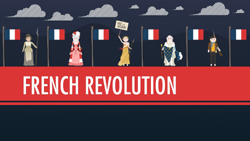By the late nineteenth century, the Second Industrial
Revolution made the economies of most European nations even more productive.
Electricity and the internal-combustion engine transformed most of the
European world into industrialized societies. However, the transition was
not easy for workers.
Many sought reform through trade unions or socialism
to improve their lives.
The Second Industrial Revolution
-
In Western Europe, the introduction of electricity, chemicals,
and petroleum triggered the Second Industrial Revolution, and a world economy
began to develop.
In the late nineteenth century, the belief in progress was
so strong in the West that it was almost a religion. Europeans and Americans
had been impressed by the stunning bounty of the Second Industrial Revolution.
The first Industrial Revolution had given rise to textiles, railroads,
iron, and coal. In the Second Industrial Revolution, steel, chemicals,
electricity, and petroleum were the keys to making economies even more
productive.
New Products
One major change in industry between 1870 and 1914 was
the substitution of steel for iron. Steel was used in the building of lighter,
smaller, and faster machines and engines. It was also used in railways,
ships, and weapons. In 1860 Great Britain, France, Germany, and Belgium
produced 125,000 tons (112,500 t) of steel.
By 1913, the total was an astounding 32 million tons (29
million t).
Electricity was a major new form of energy that proved
valuable. It was easily converted into other energy forms such as
heat, light, and motion. Electricity also moved easily through space by
means of wires. In the 1870s, the first practical generators of electrical
current were developed. By 1910, hydroelectric power stations and coal-fired,
steam-generating plants connected homes and factories to a single, common
source of power.
Electricity gave birth to a series of inventions. Homes
and cities began to have electric lights when Thomas Edison
in the United States and Joseph Swan in Great Britain created
the light bulb.
Edison patented the first commercially practical incandescent
light. In 1878, with the help of several financiers, including J. P. Morgan,
Edison formed the Edison Electric Light Company in New York City.
It was during this time that Edison remarked, “We will
make electricity so cheap that only the rich will burn candles.”
A revolution in communications also began. Alexander
Graham Bell invented the telephone in 1876. Guglielmo Marconi
sent the first radio waves across the Atlantic in 1901. Marconi made this
report of his remarkable discovery:
“Shortly before mid-day I placed the single earphone
to my ear and started listening.... I was at last on the point of
putting... my beliefs to the test.... The electric waves sent out
into space from Britain had traversed the Atlantic—the distance... of 1,700
miles—It was an epoch in history. I now felt for the first time absolutely
certain the day would come when mankind would be able to send messages
without wires... between the farthermost ends of the earth.”
By the 1880s, streetcars and subways powered by electricity
had appeared in major European cities. Electricity transformed the factory
as well. Conveyor belts, cranes, and machines could all be powered by electricity.
With electric lights, factories could remain open 24 hours a day.
The development of the internal-combustion engine, fired
by oil and gasoline, provided a new source of power in transportation.
This engine gave rise to ocean liners with oil-fired engines,
as well as to the airplane and the automobile.
In 1903 Orville and Wilbur Wright made the first flight
in a fixed-wing plane at Kitty Hawk, North Carolina. In 1919 the first
regular passenger air service was established.
New Patterns
Industrial production grew at a rapid pace because of
greatly increased sales of manufactured goods. Europeans could afford to
buy more consumer products for several reasons. Wages for workers increased
after 1870. In addition, prices for manufactured goods were lower because
of reduced transportation costs. One of the biggest reasons for more efficient
production was the assembly line, a new manufacturing method
pioneered by Henry Ford in 1913. The assembly line allowed
a much more efficient mass production of goods.
In the cities, the first department stores began to sell
a new range of consumer goods. These goods—clocks, bicycles, electric lights,
and typewriters, for example—were made possible by the steel and electrical
industries.
Not everyone benefited from the Second Industrial Revolution.
By 1900, Europe was divided into two economic zones. Great Britain, Belgium,
France, the Netherlands, Germany, the western part of the AustroHungarian
Empire, and northern Italy made up an advanced industrialized core.
These industrialized nations had a high standard of living
and decent systems of transportation.
Another part of Europe was still largely agricultural.
This was the little-industrialized area to the south and east. It consisted
of southern Italy, most of Austria-Hungary, Spain, Portugal, the Balkan
kingdoms, and Russia. These countries provided food and raw materials for
the industrial countries and had a much lower standard of living than the
rest of Europe.
Toward a World Economy
The Second Industrial Revolution, combined with the growth
of transportation by steamship and railroad, fostered a true world economy.
By 1900, Europeans were receiving beef and wool from Argentina and Australia,
coffee from Brazil, iron ore from Algeria, and sugar from Java. European
capital was also invested abroad to develop railways, mines, electrical
power plants, and banks. Of course, foreign countries also provided markets
for Europe’s manufactured goods. With its capital, industries, and military
might, Europe dominated the world economy by the beginning of the twentieth
century.
Question:
Why did Europe dominate the world economy by the
beginning of the twentieth century?
REVIEW & DO
NOW
Answer the following questions in your spiral notebooks: |
| . |
. |
|
|
The Working Class
Industrialization gave some a higher standard of
living, but struggling workers turned to trade unions or socialism to improve
their lives.
The transition to an industrialized society was very hard
on workers. It made their lives difficult and forced them to live in crowded
slums. They had to work long hours at mind-numbing tasks. This transition
eventually gave workers a higher standard of living.
Goals for Reform
Reformers of this era believed that industrial capitalism
was heartless and brutal.
They wanted a new kind of society. Some reformers were
moderates. They were willing to work within the system for gradual changes
such as fewer hours, better benefits, and safe working conditions. Often
they used trade unions to achieve these practical goals.
Other reformers were more radical. They wanted to abolish
the capitalist system entirely and create a socialist system. To achieve
this goal, they supported socialist parties. Socialist parties emerged
after 1870, but the theory on which they were based came largely from Karl
Marx. One form of Marxist socialism was eventually called communism.
Marx’s Theory
In 1848 The Communist Manifesto was published. It was
written by two Germans, Karl Marx and Friedrich Engels,
who were appalled at the horrible conditions in the industrial factories.
They blamed the system of industrial capitalism for these conditions.
Marx believed that all of world history was a “history
of class struggles.” According to Marx, oppressor and oppressed have always
“stood in constant opposition to one another.” One group—the oppressors—owned
the means of production, such as land, raw materials, money, and so forth.
This gave them the power to control government and society.
The other group, who owned nothing and who depended on the owners of the
means of production, was the oppressed.
In the industrialized societies of Marx’s day, the class
struggle continued. Around him, Marx believed he saw a society that was
“more and more splitting up into two great hostile camps, into two great
classes directly facing each other: Bourgeoisie and Proletariat.” The bourgeoisie—the
middle class—were the oppressors. The proletariat—the working
class—were the oppressed.
Marx predicted that the struggle between the two groups
would finally lead to an open revolution. The proletariat would violently
overthrow the bourgeoisie. After their victory, the proletariat would form
a dictatorship (a government in which a person or small group
has absolute power) to organize the means of production. However, since
the proletariat victory would essentially abolish the economic differences
that create separate social classes, Marx believed that the final revolution
would ultimately produce a classless society. The state itself, which had
been a tool of the bourgeoisie, would wither away.
Socialist Parties
In time, working-class leaders formed socialist parties
based on Marx’s ideas. Most important was the German Social Democratic
Party (SPD), which emerged in 1875. Under the direction of its Marxist
leaders, the SPD advocated revolution while organizing itself into a mass
political party that competed in elections for the German parliament.
Once in parliament, SPD delegates worked to pass laws
that would improve conditions for the working class.
In spite of government efforts to destroy it, the German
Social Democratic Party grew. When it received four million votes in the
1912 elections, it became the largest single party in Germany. Because
the German constitution gave greater power to the upper house and the German
emperor, the SPD was not able to bring about the kind of changes it wanted.
Socialist parties also emerged in other European states.
In 1889 leaders of the various socialist parties joined
together and formed the Second International. This was an association of
national socialist groups that would fight against capitalism worldwide.
(The First International had failed in 1872.)
Marxist parties were divided over their goals. Pure Marxists
thought that capitalism could only be defeated by a violent revolution.
Other Marxists, called revisionists, rejected the revolutionary
approach. They argued that workers must continue to organize in mass political
parties and even work with other parties to gain reforms. As workers received
the right to vote, revisionists believed, they could achieve their aims
by working within democratic systems.
Trade Unions
Another force working for evolutionary, rather than revolutionary,
socialism was the trade union, or labor union.
To improve their conditions, workers organized in a union.
Then the union had to get the employer to recognize its
right to represent workers in collective bargaining. This is a process
whereby union representatives negotiate with employers over wages and hours.
The right to strike was another important part of the
trade union movement. In a strike, a union calls on its members to stop
work in order to pressure employers to meet their demands for higher wages
or improved factory safety. At first, laws were passed that made strikes
illegal under any circumstances. In Great Britain, unions won the right
to strike in the 1870s. By 1914, there were almost four million workers
in British trade unions. In the rest of Europe, trade unions had varying
degrees of success in helping workers achieve a better life.
REVIEW & DO
NOW
Answer the following questions in your spiral notebooks: |
| . |
. |
|
|
|





